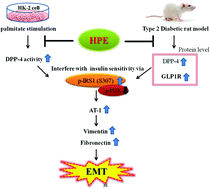Hibiscus sabdariffa polyphenols prevent palmitate-induced renal epithelial mesenchymal transition by alleviating dipeptidyl peptidase-4-mediated insulin resistance†
Abstract
Diabetic nephropathy has a significant socioeconomic impact, but its mechanism is unclear and needs to be examined. Hibiscus sabdariffa polyphenols (HPE) inhibited high glucose-induced angiotensin II receptor-1 (AT-1), thus attenuating renal epithelial mesenchymal transition (EMT). Recently, we reported HPE inhibited dipeptidyl-peptidase-4 (DPP-4, the enzyme degrades type 1 glucagon-like peptide (GLP-1)), which mediated insulin resistance signals leading to EMT. Since free fatty acids can realistically bring about insulin resistance, using the palmitate-stimulated cell model in contrast with type 2 diabetic rats, in this study we examined if insulin resistance causes renal EMT, and the preventive effect of HPE. Our findings reveal that palmitate hindered 30% of glucose uptake. Treatment with 1 mg mL−1 of HPE and the DPP-4 inhibitor linagliptin completely recovered insulin sensitivity and palmitate-induced signal cascades. HPE inhibited DPP-4 activity without altering the levels of DPP-4 and the GLP-1 receptor (GLP-1R). HPE decreased palmitate-induced phosphorylation of Ser307 of insulin receptor substrate-1 (pIRS-1 (S307)), AT-1 and vimentin, while increasing phosphorylation of phosphatidylinositol 3-kinase (pPI3K). IRS-1 knockdown revealed its essential role in mediating downstream AT-1 and EMT. In type 2 diabetic rats, it suggests that HPE concomitantly decreased the protein levels of DPP-4, AT-1, vimentin, and fibronectin, but reversed the in vivo compensation of GLP-1R. In conclusion, HPE improves insulin sensitivity by attenuating DPP-4 and the downstream signals, thus decreasing AT-1-mediated tubular-interstitial EMT. HPE could be an adjuvant to prevent diabetic nephropathy.


 Please wait while we load your content...
Please wait while we load your content...